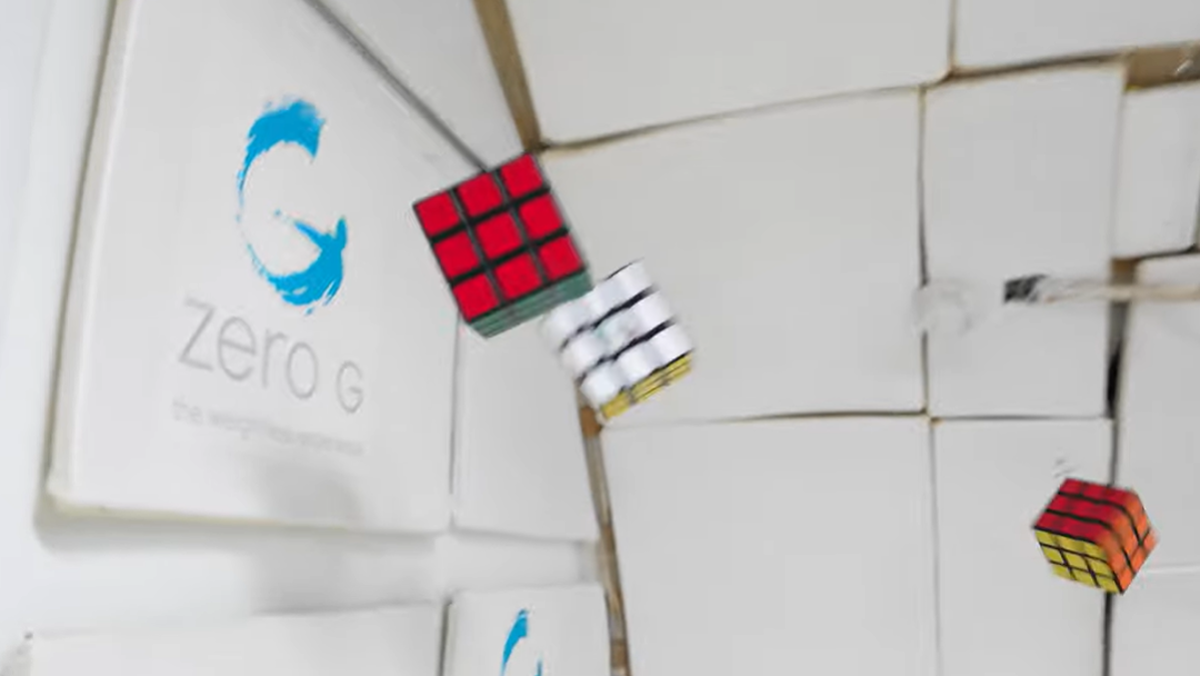Rubik's Cube solved in 19 seconds during zero-gravity flight (video)
Bailey Burns learned how to 'speed cube' to solve the Rubik's Cube puzzle in 19 seconds during a parabolic flight.
An analog astronaut swiftly solved a Rubik's Cube puzzle while floating in microgravity.
Aerospace engineer Bailey Burns, 26, completed the famous Rubik's Cube in just 19 seconds during a "Vomit Comet" parabolic flight sponsored by the gaming company Rubik's this past April.
It took two years to get the puzzle-solving flight off the ground due to numerous pandemic delays, but Burns said the extra time was helpful in letting her practice "speed cubing." She was ultimately able to halve her time from a personal best of 42 seconds to a consistent 20.
Related: Watch a robot solve a Rubik's Cube in 0.38 seconds
Burns gleefully floated, threw cubes and did brief flips with participants during the flight, which alternated several cycles between about 30 seconds of microgravity and about two minutes being pinned to the floor at double the force of Earth's gravity.
"What we're talking about here is being curious, being creative, being determined, and just having fun with it," Burns said in a short video about the flight, which took place April 9 and included Inspiration4 astronaut Sian Proctor. (Proctor and Burns are longtime friends; they both spent time at the HI-SEAS analog astronaut facility during different missions.)
Don’t miss the first-ever Solver Stories! Watch @ninjaneergirl as she attempts to achieve her long-awaited dream of solving a #RubiksCube in Zero Gravity with @GoZeroG !https://t.co/6Bk8lz6DSW#RubiksZeroG #TwistTurnLearn #BaileyBurns #NinjaneerGirl #GoZeroG pic.twitter.com/ONq9YnPao6August 18, 2022
Rubik's Cube was created in 1974 by Hungarian design teacher Erno Rubik. Initially called the Magic Cube, marketers renamed it to Rubik's Cube and began selling it in stores in 1980. Within two years, 100 million puzzle solvers bought the multi-colored cube, according to the Museum of Play.
Breaking space news, the latest updates on rocket launches, skywatching events and more!
Rubik's Cube and its potential to engage students in solving problems is still getting attention from teachers in Colorado, who have been asking Burns (a resident of the Centennial state) to come into classes to talk about Rubik's Cube as the school year takes shape.

Burns, who works an environmental control and life systems engineering job when she doesn't have a cube in her hands, says she is trying to build a career that will take her to space without going through the usual route.
"I really love the space tourism industry," she said when asked if she would try a suborbital flight with Blue Origin or Virgin Galactic. But Burns is more interested in trying to get the moon, which NASA is working on with the Artemis program.
Burns suggests that perhaps her work in life systems might get her in space somehow. "I'm really focused on cislunar infrastructure or lunar infrastructure, so when I go to space, I want to make sure it's for keeping humans alive."
Follow Elizabeth Howell on Twitter @howellspace. Follow us on Twitter @Spacedotcom or Facebook.

Elizabeth Howell (she/her), Ph.D., was a staff writer in the spaceflight channel between 2022 and 2024 specializing in Canadian space news. She was contributing writer for Space.com for 10 years from 2012 to 2024. Elizabeth's reporting includes multiple exclusives with the White House, leading world coverage about a lost-and-found space tomato on the International Space Station, witnessing five human spaceflight launches on two continents, flying parabolic, working inside a spacesuit, and participating in a simulated Mars mission. Her latest book, "Why Am I Taller?" (ECW Press, 2022) is co-written with astronaut Dave Williams.

